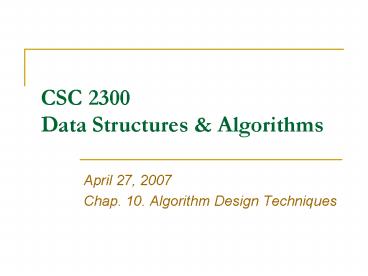CSC 2300 Data Structures - PowerPoint PPT Presentation
Title:
CSC 2300 Data Structures
Description:
The ASCII character set consists of about 100 'printable' characters. ... A file with only the characters a, e, i, s, t, blankspace, newline. ... – PowerPoint PPT presentation
Number of Views:50
Avg rating:3.0/5.0
Title: CSC 2300 Data Structures
1
CSC 2300Data Structures Algorithms
- April 27, 2007
- Chap. 10. Algorithm Design Techniques
2
Today
- File Compression
- Huffman Code
3
ASCII
- What does ASCII stand for?
- The ASCII character set consists of about 100
printable characters. - How many bits to represent these characters?
- The set includes some nonprintable characters.
- An 8th bit is added as a parity bit.
4
Example
- A file with only the characters a, e, i, s, t,
blankspace, newline. - There are seven characters, and so three bits are
sufficient. - i see a seat
- 010101011001001101000101011001000100110 (39
bits) - How to do better?
5
Binary Tree
- Binary tree
- The data reside only at the leaves.
- Can you improve this representation?
6
Example
- newline becomes 11
- i see a seat
- 01010101100100110100010101100100010011 (38 bits)
- A reduction of 1 bit.
- Want more significant improvement.
- How?
7
The Two Trees
- What can you say about the structure of the
better tree? - It a a full tree.
- All nodes either are leaves or have two children.
- An optimal code will always have this property.
- Why?
- Nodes with only one child can always move up one
level.
8
Prefix Code
- If the characters are placed only at the leaves,
the given sequence of bits can be decoded
unambiguously. - Prefix code no character code is a prefix of
another character code. - Example 01001111000010110001000111
- What is it?
- is
- a tie
9
Optimal Prefix Code
- Binary tree
- How to find optimal code?
10
Our Example
- i see a seat
- 1011000000101110011100000010010001 (34 bits)
- The code in the table is not optimal for our
example. - Why not?
- Exercise. Find the optimal code for our example.
11
Huffmans Algorithm
- Assume that there are C characters.
- Maintain a forest of trees.
- The weight of a tree is equal to the sum of the
frequencies of its leaves. - For C 1 times, select the two trees T1 and T2
of smallest weights, breaking ties arbitrarily,
and form a new tree with subtrees T1 and T2. - At the beginning, there are C single-node trees.
At the end, there is one single tree, which is
the optimal Huffman coding tree.
12
Example
- Initial stage
- After first merge
13
Example
- After first merge
- After second merge
- After third merge
14
Example
- After third merge
- After fourth merge
15
Example
- After fourth merge
- After fifth merge
16
Example
- After fifth merge
- After final merge
17
Implementation
- If we maintain the trees in a priority queue,
ordered by weight, what is the running time? - O( C log C ).
- We say that Huffmans method is a two-pass
algorithm. What are the two passes? - The first pass selects the frequency data and the
second pass performs the encoding.

